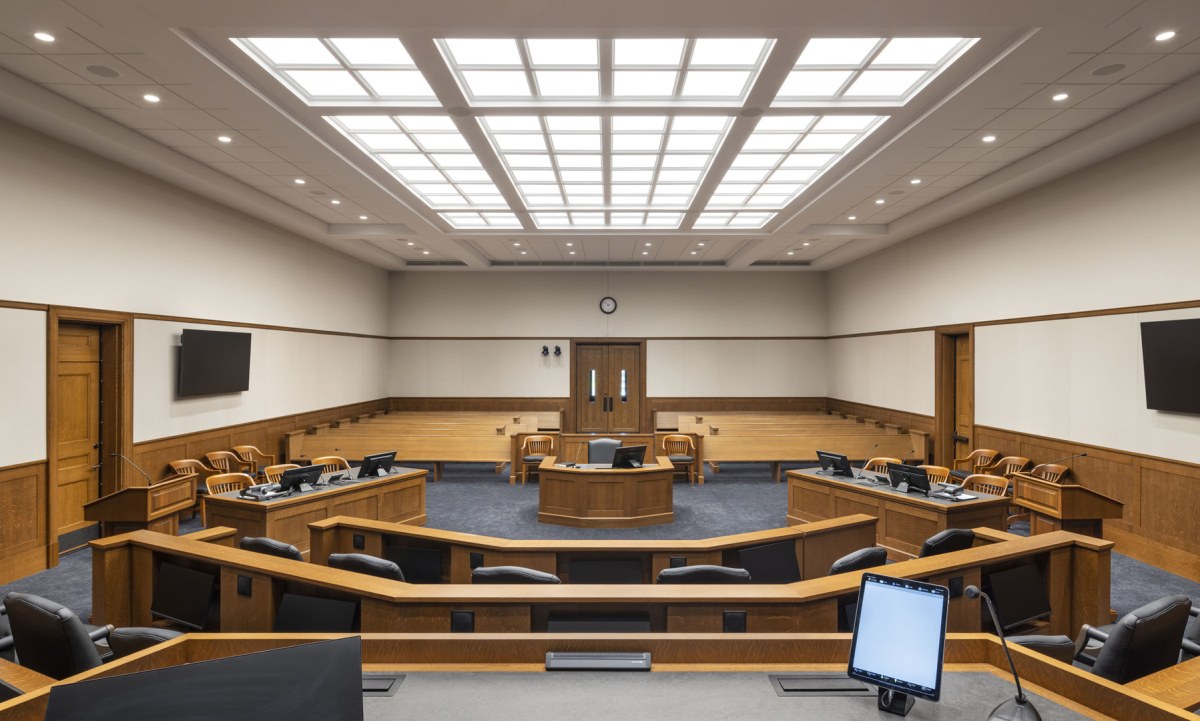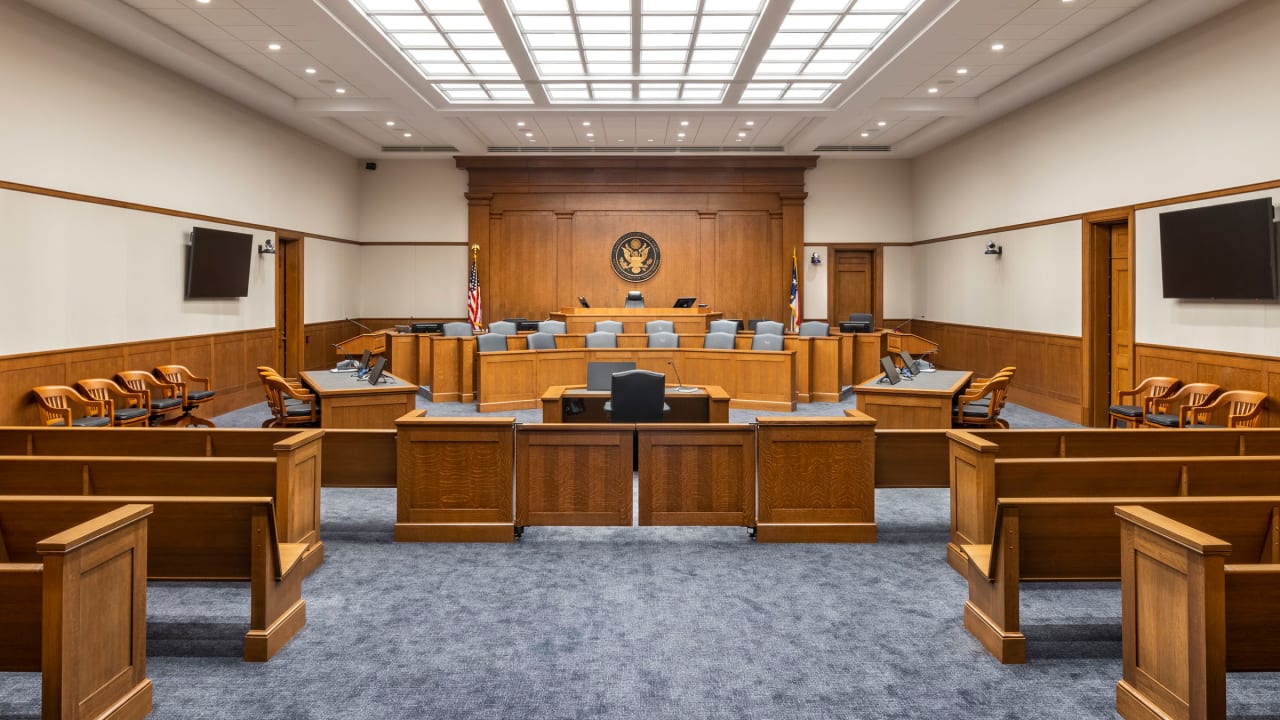Thomas Jefferson may have been onto something.
In the early 1800s in the Commonwealth of Virginia, he helped champion a specific kind of design for one of the young nation’s essential pillars. In an effort to help standardize the American court system, Jefferson had put on his architect’s cap and toured courthouses. In one, he found something unusual: a room layout that put the jury box not to the side, as most courthouses did and still do, but directly in the center of the room. He made up drawings and began evangelizing that other courtrooms in counties across the commonwealth follow suit. Many did. But outside state lines, the idea never took off.
Until now.
In Charlotte, North Carolina, a new federal courthouse building has been designed to include one jury-centered courtroom, now known as the Virginia Revival Model. U.S. District Court Judge Bob Conrad helped guide the design of the courthouse and pushed for this kind of courtroom in Charlotte. He started his career in Virginia as a young lawyer taking cases in one of the now historic courtrooms built to Jefferson’s design, and has now brought this anomaly back to life.

[Photo: courtesy RAMSA]
The layout is simple. Instead of being tucked on the side of the room, the jury box is dead center, looking out at the public gallery, and sitting below the judge who oversees the whole room. The witness box, crucially, is directly facing both the judge and jury. Lawyers tables are off to the sides and angled toward the other trial participants. Conrad calls it a better design for jury trials, taking jury members from a position of almost eavesdropping on the conversation between lawyers and witnesses to being the primary audience

[Photo: courtesy RAMSA]
“This design puts them in the middle of that conversation with an ability to observe the witness directly and judge for themselves in a better way whether the witness is being truthful or not,” says Conrad. “It also makes the witness the star. It takes the lawyers and puts them off to the side.”
This courtroom is one of nine new jury trial spaces added to the federal courthouse in Charlotte, which has recently completed a massive renovation and expansion. Designed by Robert A.M. Stern Architects (RAMSA), which is known for its traditional architectural style, the court project, and this center jury courtroom in particular, is bringing old ideas into relevance today. Grant Marani, a partner at RAMSA, argues it also brings an architectural authority befitting the seriousness of federal trials.
“There is a symmetry in that configuration that’s simply more powerful. As you walk in, it’s like a curtain has been drawn, and you see everything,” says Marani.
At the time Jefferson was visiting the architectural spaces of the Virginia’s burgeoning legal system, courthouses had gone from temporary wooden structures or rooms in big houses to more permanent brick-and-mortar structures. “The jury became more of a significant thing in the justice system,” says Conrad. “It was thought that since the jury is the judge of the facts like the judge is the judge of the law that they share authority for the fairness of a trial. Our architecture should speak to that shared authority.”
By the late 1800s, most county courthouses in Virginia used this design, including two in Charlottesville, where Conrad once practiced law. Of those historic jury-centered courtrooms, only about a dozen still exist.
“Of course they’re totally inadequate in terms of the present requirements of security, of all the technological issues we have to deal with, the sightlines,” says Marani. “So we could take inspiration but we couldn’t draw directly from the Virginia model.”
The centered jury box may come off as a novelty to anyone familiar with American legal television shows, but the spatial change is much more dramatic to the judges and lawyers who’ve spent decades working in courtrooms in the conventional mold. To help guide the design process, and to bring some of Charlotte’s judges on board, RAMSA created full-scale mockups of the proposed new courtroom, giving legal professionals the chance to see what it would feel like.

[Photo: courtesy RAMSA]
Conrad says there was some resistance at first to the new design proposal, and he’s even heard some lawyers express reluctance to argue a trial in the new courtroom. But Conrad also argues the jury-centered design does away with one of the chief problems of the conventional side-jury courtroom design: one set of lawyers is always closer to the jury than the other. The new design erases any potential for that to influence the jury, whether because they watch the closer lawyer more often or simply because they can’t hear as well when the other lawyer is talking from across the room.
Conrad also argues this new design makes juries themselves work better. Being in the center of the room, positioned straight in front of the audience, the jury has all eyes on it. “It kind of focuses their attention,” Conrad says. And because the judge is behind them, it eliminates the tendency Conrad has observed of some jury members to look at the judge to see their reaction to testimony and evidence.
Getting the design approved was no small feat. Federal courthouses are governed by a thick set of rules overseen by the General Services Administration, which also builds embassies. “We had to get 19 bureaucrats in Washington to sign off on it because it was a modification to the applicable design guidelines,” Conrad says. “But now it’s a design guideline option for any new federal courtrooms.”
Does that portend a Jeffersonian rebirth, a spreading of symmetrical courthouses and centrally aligned jury boxes across the U.S.? Maybe not any time soon.
“The federal system does not change overnight,” Marani says. “But I think when more people hear about and see this particular configuration, there will be converts.”



.png#keepProtocol)




.png#keepProtocol)
More Stories
Big Bridge Sways 2024
Top 11 Free 3D Modeling Software in 2024
Shanghai cooperation zone to bolster links between domestic, global players